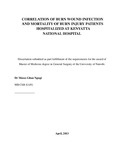| dc.contributor.author | Ngugi, Moses G | |
| dc.date.accessioned | 2013-10-25T12:02:16Z | |
| dc.date.available | 2013-10-25T12:02:16Z | |
| dc.date.issued | 2013-04 | |
| dc.identifier.citation | Moses Gitau Ngugi (2013). Correlation Of Burn Wound Infection And Mortality Of Burn Injury Patients Hospitalized at Kenyatta National Hospital. Dissertation submitted as part fulfillment of the requirements for the award of Master of Medicine degree in General Surgery of the University of Nairobi. | en |
| dc.identifier.uri | http://erepository.uonbi.ac.ke:8080/xmlui/handle/11295/57901 | |
| dc.description.abstract | Background Burn injuries are a common reason for admission at Kenyatta National Hospital (KNH) surgical wards, ranking 3rd behind road traffic accidents and head injuries in that order. Over the past two decades, burn wound infection and mortality associated with burn injury has declined tremendously worldwide. Burn wound infection is however still a common complication of burns and contributes significantly to the mortality of burn injury patients.
Objectives The aim of this study was to determine the correlation of wound infection morbidity and mortality associated with burn injury at Kenyatta National Hospital (KNH).
Methodology
This was a prospective longitudinal analytic study involving burn injury patients admitted at KNH between 20th November 2012 and 17th February 2013. Presence or absence of infection was determined clinically as well as by microscopy, culture and sensitivity of swabs taken from the burn wounds. Other investigations such as blood cultures, tissue histology and x-rays were done where indicated.
Acute complications, including mortality, associated with burn injuries and the respective severity were documented.
Statistical Package for Social Sciences software version 20 was used for data analysis. A confidence interval of 95%, Spearman‟s rho and Pearson‟s correlation coefficient were used in the analysis.
Results
Out of 93 burn patients admitted at KNH most got injured while at their homes either by hot water (45%) or dry flames (30%) from burning houses. This affected mostly children and young adults (75.2%). Children under 10 years of age made up about 27%.
All 56 patients who suffered from fluid and electrolyte imbalance had appropriate fluid and electrolyte replacement (100%) and therefore none of them suffered from any acute renal failure. Twenty nine patients (31%) had inhalational injuries with16 of them being intubated with endotracheal tube (ETT). Three patients had pneumonia which was appropriately treated. The incidence of pneumonia among patients intubated with ETT was 13% (2/16).
Among those patients who needed early surgical intervention (39) of escharectomy and skin grafting (within 14 days post-burn), only 2 (5.1%) had it done.
The overall rate of burn wound infection at KNH was 23.6% (22/93 cases) and the overall mortality rate among burn injury patients was 14% (10/93 cases).
From Spearman‟s and Pearson‟s correlation coefficient calculated, there was a 0.677 correlation coefficient of burn wound infection and mortality in burn injuries patients admitted at KNH.
This implied that if the infection rate in burn wound was high, then the mortality rate would be high as well.
Conclusion
The protocol of management in fluid and electrolyte replacement was well practiced; thus there was no patient who got acute renal failure. Those patients who were intubated with ETT were appropriately managed to prevent pneumonia associated with ETT and burn injury to airway.
The rate of burn wound infection in this study was higher than that of the previous retrospective study of 1995. The overall mortality rate had not changed over the last 40 years.
The results of this study showed that there was a strong relationship between burn wound infection and mortality associated with burn injuries in patients admitted a KNH. | en |
| dc.language.iso | en | en |
| dc.publisher | University of Nairobi | en |
| dc.title | Correlation of burn wound infection and mortality of burn injury patients hospitalized at Kenyatta national hospital | en |
| dc.type | Thesis | en |
| dc.description.department | a
Department of Psychiatry, University of Nairobi, ; bDepartment of Mental Health, School of Medicine,
Moi University, Eldoret, Kenya | |
| local.publisher | School of Medicine | en |

